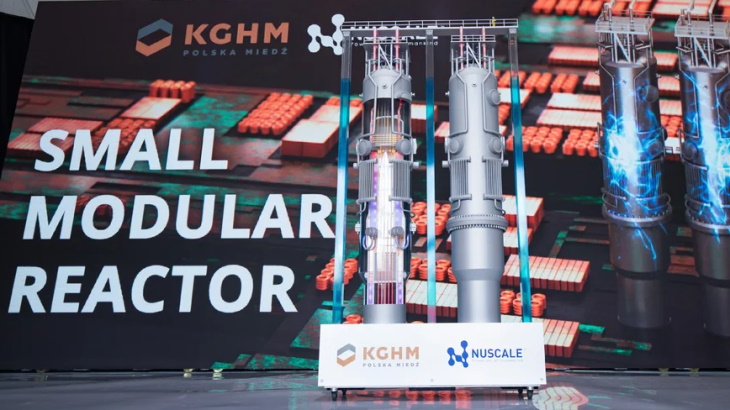Polish copper and silver producer KGHM Polska Miedź SA has submitted an application to the country's Ministry of Climate for a decision-in-principle on the construction of a small modular reactor (SMR) power plant.

A model of a NuScale SMR (Image: KGHM)
KGHM lodged the application on 14 April - the same day that Polskie Elektrownie Jądrowe applied for a decision-in-principle on the construction of Poland's first large-scale nuclear power plant.
The decision-in-principle is the first decision in the administrative permit process for investments in nuclear power facilities in Poland that an investor can apply for, KGHM noted. It said obtaining the decision-in-principle is "an expression of the state's support for the implementation of a given project and entitles one to apply for a number of subsequent administrative decisions, such as the siting decision or the construction permit, among others".
"Until the completion of the administrative procedure, KGHM will not provide information on the progress of the proceedings and details of the application," the company added.
In February 2022, KGHM signed a definitive agreement with NuScale Power of the USA to initiate work towards deploying a first NuScale VOYGR SMR power plant in Poland as early as 2029. In July, KGHM submitted an application to Poland's National Atomic Energy Agency (NAEA) to evaluate NuScale's SMR technology and prepare a site study. Under a task order signed in September, NuScale will continue to support KGHM's application to the NAEA through activities including drafting additional preliminary safety analysis reports and coordinating with the NAEA. The task order also sets the stage for the subsequent tasks in the Early Works Agreement as proposed by NuScale to KGHM.
The VOYGR nuclear power plant project that Poland will develop, in cooperation with NuScale, will have six modules, each with an installed capacity of 77 MWe. NuScale's SMR technology is the first to have gained approval from the US Nuclear Regulatory Commission, in August 2020. NuScale offers VOYGR plants in 12, four and six-module configurations.
KGHM aims to diversify its energy sources. By 2030, 50% of the electricity used by KGHM will come from its own sources, including nuclear and renewables.
"KGHM is one of the largest Polish companies and at the same time one of the largest energy consumers in the country," said KGHM President Tomasz Zdzikot. "That is why our involvement in energy projects, among which the nuclear project is of primary importance, is obvious. This is a project which will guarantee the stability of our operations in the future.
"Taking into account the scale of KGHM's demand, the company's energy transformation towards renewable sources and nuclear reactors will also be an important element of the entire Polish energy mix."
Government backing for SMRs
On 17 April, Orlen Synthos Green Energy announced it had shortlisted seven locations in Poland for further geological surveys to host SMR plants based on GE Hitachi Nuclear Energy's BWRX-300, for which it holds the exclusive right in Poland.
The announcement was made during a conference organised by the Orlen Group to discuss the implementation of its strategic plans in the area of nuclear energy.
Speaking at the conference, Polish Prime Minister Mateusz Morawiecki said: "Our future depends on a prudent programme of building nuclear energy in Poland, the future of the energy sector in Poland, but also the future of industry and the future of economic development. The atom, and especially the so-called 'small atom', is a very good way to quickly replenish our resources. Poland needs cheap and clean energy sources. We are modernising the Polish energy sector in order to provide such sources in the shortest possible time".
He noted that through the installation of one SMR reactor, it will be possible to save EUR100-200 million annually on CO2 emissions by not having to purchase CO2 emission allowances.
"It also means more income for communes, powiats and local governments, not only in large cities, but also in smaller cities and towns that need it. Not only clean heat energy, clean electricity, but also income for municipalities," Morawiecki said. "It is also new jobs, hundreds of thousands of jobs, not only in construction, but also the creation of a whole new sector of industrial production in the broader sense of the word. It is a great success because it means new jobs, technology transfer, great development opportunities for small and medium-sized Polish companies".